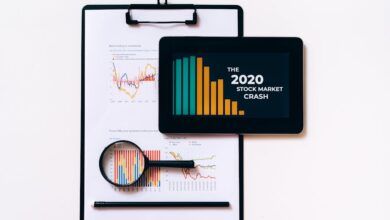Riding the Economic Wave: Understanding Recession Signals, Strategies for Resilience, and Lessons for the Future

As economic cycles ebb and flow, the specter of recession looms as a significant concern for policymakers, investors, and businesses alike. Understanding the early warning signs of an impending downturn is crucial for mitigating risks and adapting strategies. This article delves into the multifaceted impact of recessions on various sectors, exploring how they alter consumer behavior, disrupt global trade, and strain supply chains. We will also examine effective investment strategies during turbulent times, the pivotal role of government stimulus in cushioning the blow, and the lessons learned from past recessions that remain relevant today. Through a detailed analysis of these elements, we aim to equip readers with the insights necessary to navigate economic uncertainty and enhance their resilience in the face of adversity. Join us as we uncover the red flags of recession, smart investment strategies, and proactive measures businesses can adopt to not only survive but thrive in challenging economic landscapes.
- 1. **Identifying the Red Flags: Early Warning Signs of Economic Recession**
- 2. **Navigating the Storm: Strategies for Smart Investing During Economic Downturns**
1. **Identifying the Red Flags: Early Warning Signs of Economic Recession**
Identifying early warning signs of an economic recession is crucial for businesses, investors, and policymakers to take preemptive actions. Several key indicators can signal an impending downturn, often leading to shifts in economic sentiment and activity.
One of the most widely monitored indicators is the unemployment rate. A rise in unemployment, particularly if it occurs rapidly, can suggest that companies are facing reduced demand and are beginning to cut back on their workforce. This can lead to decreased consumer spending, further exacerbating economic decline.
Another significant red flag is a decline in consumer confidence. When consumers feel uncertain about their financial future, they tend to reduce spending, which is a major driver of economic growth. Surveys measuring consumer sentiment can provide insights into potential shifts in spending patterns.
Additionally, changes in the yield curve—specifically an inverted yield curve—have historically been seen as a reliable predictor of recessions. When short-term interest rates exceed long-term rates, it indicates a lack of confidence in future economic growth, prompting investors to seek safer, long-term investments.
Furthermore, declining retail sales and manufacturing output are critical indicators. A sustained decrease in these areas can signal that businesses are struggling to maintain sales and production levels, often leading to a broader economic slowdown.
Another important factor is the performance of the stock market. A significant and sustained drop in equity prices can reflect investor concerns about economic conditions, leading to reduced wealth and spending.
Monitoring these early warning signs can help stakeholders make informed decisions. By recognizing these indicators, businesses and individuals can adjust their strategies to mitigate potential risks associated with an economic recession.
Economic recessions are characterized by a decline in economic activity, typically measured by a decrease in gross domestic product (GDP) for two consecutive quarters. Early warning signs often include rising unemployment rates, decreasing consumer confidence, and a slowdown in manufacturing and retail sales. Analysts closely monitor indicators such as the yield curve, which can invert prior to a recession, and leading economic indicators that signal potential declines in business activity.
Different sectors of the economy react variably to recessions. For example, luxury goods and travel industries often suffer as consumers tighten their budgets, while essential services, like healthcare and utilities, may remain stable or even grow. The real estate market frequently experiences a downturn, with reduced demand leading to falling property prices. Conversely, discount retailers may see increased sales as consumers seek more affordable options.
Investing strategies during a recession should prioritize defensive assets. Investors often shift their portfolios toward sectors that tend to be more resilient in downturns, such as consumer staples, healthcare, and utilities. Bonds and dividend-paying stocks can also provide stability, while cash reserves enable investors to take advantage of opportunities when market prices decline.
Government stimulus plays a crucial role in mitigating the impact of recessions. Through measures such as monetary policy adjustments, tax cuts, and direct financial aid to individuals and businesses, governments aim to boost spending and support economic recovery. Historical examples, like the American Recovery and Reinvestment Act of 2009, demonstrate how targeted stimulus can help stabilize the economy and foster growth.
Consumer behavior typically shifts during economic downturns, with increased saving rates and a focus on necessities rather than discretionary spending. This change can lead to altered shopping habits and preferences for value-oriented products. Businesses must adapt their marketing strategies to resonate with cost-conscious consumers while emphasizing quality and value.
Recessions also have far-reaching effects on global trade and supply chains. Reduced consumer demand leads to a decline in exports, affecting countries that rely heavily on trade. Supply chains may become strained as businesses cut back on production and procurement, highlighting vulnerabilities in global interdependencies.
Lessons from past recessions, such as the Great Depression or the 2008 financial crisis, underscore the importance of financial preparedness and adaptability. Businesses that maintain strong cash reserves, diversify their revenue streams, and invest in technology are often better positioned to weather economic storms.
To prepare for and survive a recession, businesses should conduct risk assessments, streamline operations, and enhance customer engagement. Building strong relationships with suppliers and exploring alternative sourcing options can improve resilience, while staying attuned to market trends and consumer needs enables businesses to pivot quickly in response to changing economic conditions.
2. **Navigating the Storm: Strategies for Smart Investing During Economic Downturns**
Investing during an economic downturn can be challenging, but with the right strategies, investors can not only protect their capital but also identify opportunities for growth. One key approach is to focus on defensive stocks, which tend to be less sensitive to economic cycles. These include companies in sectors such as utilities, healthcare, and consumer staples, which provide essential goods and services regardless of economic conditions.
Another strategy is to diversify investments across different asset classes, including bonds and commodities, to reduce overall portfolio risk. Bonds can provide a stable income stream during volatile periods, while commodities like gold often serve as a safe haven, preserving value when stock markets decline.
Investors should also consider adopting a long-term perspective. Market downturns can create attractive buying opportunities, allowing investors to purchase quality assets at lower prices. By maintaining a disciplined approach and avoiding panic selling, investors can position themselves for recovery when the economy rebounds.
Additionally, it’s beneficial to keep an eye on cash reserves. Having liquidity allows investors to take advantage of opportunities as they arise, such as acquiring undervalued stocks or real estate.
Lastly, staying informed about economic indicators and government policy responses is crucial. Understanding fiscal and monetary measures, such as interest rate changes and stimulus packages, can guide investment decisions and help anticipate market movements. By employing these strategies, investors can navigate the storm of a recession and emerge stronger on the other side.
In conclusion, understanding the multifaceted nature of economic recessions is crucial for both individuals and businesses alike. By identifying early warning signs, such as declining consumer confidence and rising unemployment rates, stakeholders can take proactive measures to mitigate potential impacts. While recessions can adversely affect various sectors, from retail to manufacturing, they also present unique investment opportunities for those who know how to navigate the market's uncertainties.
Government stimulus plays a pivotal role in cushioning the blow, helping to stabilize economies and support vulnerable sectors, while shifts in consumer behavior can reveal emerging trends that savvy businesses can capitalize on. Additionally, the lessons learned from past recessions—such as the importance of liquidity, diversification, and strategic planning—remain highly relevant in today’s economic landscape.
As we move forward, businesses must focus on resilience and adaptability, preparing for potential downturns by building robust strategies that emphasize financial health and operational flexibility. By doing so, they can not only survive but thrive in the face of economic challenges, ensuring long-term sustainability and growth. Ultimately, by fostering a comprehensive understanding of recession dynamics, we can better equip ourselves to face the inevitable economic cycles that shape our global landscape.





